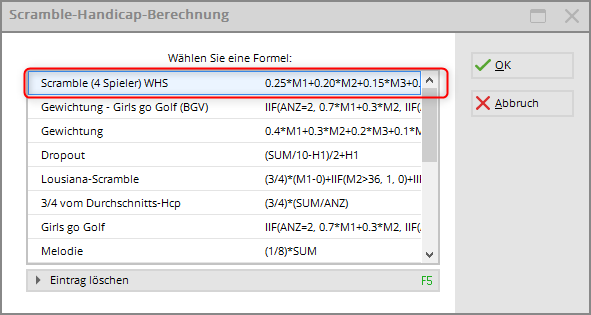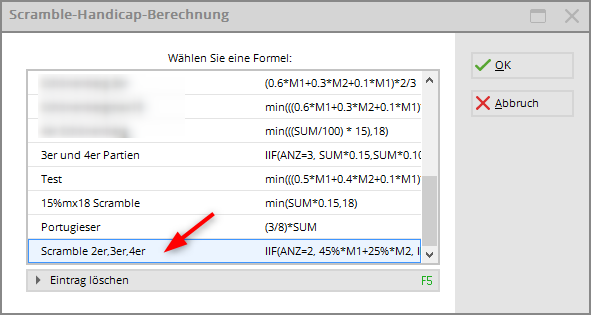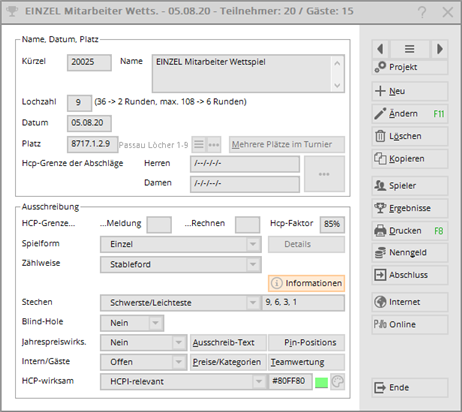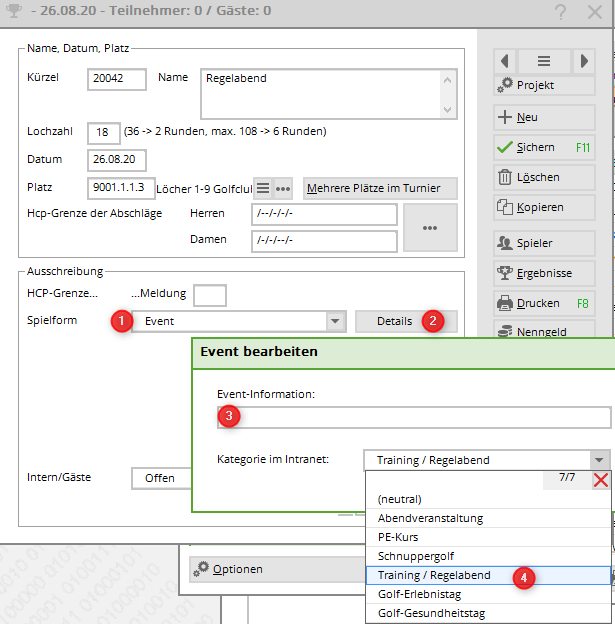Inhaltsverzeichnis
WHS Tournament Information General
Read here in particular Explanations of the different forms of play and calculations of the course handicaps.
With the introduction of the WHS (World Handicap System) there are changes to the calculation of course handicaps for some forms of play! Please pay particular attention to the information on 2-person scramble and scramble (the formula for scramble must be actively selected in the formula selection for each tournament! Otherwise „Teacher Scramble is calculated“)
new terms and abbreviations with the WHS
- WHS - World Handicap System
- Handicap Index - HCPI
- Course handicap (according to course rating table for individual players)
- Playing handicap - common HCP for foursomes, or a reduced handicap also for a single player with e.g. HCP factor 90%, or also 100% handicap.
- Penalty score: fictitious result, is entered for the player who has not submitted an HCPI-relevant result (see rule 7.1b of the handicap rules, valid from 2021, licensed for the DGV)
Click here for the DGV Service Portal and information on the WHS:
HCP Rules briefly explained
Season HCPI-relevant
In the Switzerland and Austria you can still set the HCPI relevance according to the regulations without an external check.
Germany
During the season (May to September), only HCPI-relevant tournaments are permitted by the DGV intranet and must be completed accordingly. This is controlled by a check of HCPI relevance via the DGV intranet.
Exceptions must be clarified by the club with the DGV.
Outside the specified season (October to April), tournaments can be played „NOT HCPI-relevant“, but of course also HCPI-relevant.
HCPI relevance check (Germany)
When you send a tournament to the intranet, the setting for HCPI relevance is automatically checked at the DGV and a response is sent, which you can then see in the information window:
Tournament conclusion for HCP index
Read about this directly at ⇒Tournament conclusion
Penalty Score
A penalty score is added to a player's scoring record or handicap history sheet, as determined by the captain.
Please read the „Handicap rules, valid from 2021, licensed for the DGV“.
To apply for deposit by the DGV, simply send a short email to handicap@dgv.golf.de to be contacted by the club (captain).
Single
The usual formula for calculating the individual course handicap from the HCP index is
Course handicap = HCPI x Slope / 113 + CR - Par
(see World Handicap System, valid from 2021, licensed for the DGV)
The course handicap may also be supplemented by the fields „Calculate Hcp limit“ or the „Hcp factor“ fields. The „Hcp limit“ places an upper limit on the player's course handicap, i.e. the course handicap will be no higher than for a player with the HCP index entered here. This limit is also possible in handicap-relevant tournaments, as PC CADDIE always calculates the rated gross score (GBE) on the basis of the full course handicap (maximum par+5).
The „Hcp factor“ is calculated on the course handicap. For example, if you enter „3/4“ here, a player who would normally have a course handicap of 20 will play with a course handicap of 15 in the competition.
Calculation of the course handicap example for 18 holes
- For a player with an HCP index of „22.3“ on a course with a slope rating of 132 and a course rating of 71.3 on a par 72, the result is as follows Course-Handicap:
22.3*132/113+71.3-72=25.34 = 25
According to this example, the course rating table is also calculated according to this example.
Counting method par/bogey (previously "against par")
It is against the par of the course whereby the course handicap is distributed over the holes according to the handicap distribution. A score of +, 0 or - is then determined for each hole. At the end, the pluses and minuses are set off against each other. This form of play is handicap-relevant. PC CADDIE calculates the gross score to be assessed (GBE) Read our practical examples Tournaments against par.
The calculated Stableford points are not determined by calculating individual holes, but by adding by adding 36 to the total score. This means that a total par/bogey result of +2 (= „2 up“)
directly becomes 38 Stableford points. This is important because par/bogey can be played strategically differently and the player can pick up the ball one stroke earlier than with Stableford.
(see also World Handicap System, valid from 2021)
HCP limit for foursomes
The field message field is used in the same way as for singles and only applies to the individual player.
The field Calculate Hcp limit field limits the course handicap for all foursomes competitions as follows:
- If the limit is less than or equal to 45this limit is calculated per player (for both singles and foursomes), i.e. if you enter 28.0 here, for example, a player with an HCP index of 33.2 will be counted as having a course handicap of 28.0 for the purposes of sorting in the results list.
- From limit 46 and higherthis is used as the upper limit of the sum of the two HCPI is understood. For example, if 48.0 is entered here, a pair of players who actually have an HCP index of 33.2 or 18.5 will be calculated internally with an HCPI of 30.8 or 17.2, so that the sum is equal to the desired upper limit if the ratio between the players is the same.
Erklärung: Frequently used limits are 48 or, for example, 56, which is then the upper limit for
the common course handicap (the sum of the HCPI).
An entry of Calculate Hcp limit 54 for the individual player would be unnecessary,
as this is the highest possible handicap, a maximum of 54 is calculated anyway.
If the limit is exceeded for a pairing, both are reduced proportionately.
reduced proportionately.
A simple Beispiel: If the limit of the
common course handicap is 48 and one player has HCPI 54 and the other 42,
the two are twice as high at 96. The HCPI are therefore
halved in order to fulfil the requirement of 48.
So one is counted with an HCPI of 27.0 and the other with 21.0 for the tournament.
tournament - and the course handicap is then calculated from this.
is then calculated.
Another calculation example also with limit 48:
Player 1 has HCI 22.2 and player 2 has HCPI 35.9, which adds up to more than 48, namely 58.1 - the question now is, how are the two Hcps reduced so that they add up to 48 again?
You do the maths like this:
HCPI 22.2
⇒ effective 22.2*(48/(22.2+35.9)) = 18.3
HCPI 35.9
⇒ effective 35.9*(48/(22.2+35.9)) = 29.7
in the end 18.3 +29.7 result in a maximum of 48
Tee selection for foursomes with a common playing handicap
The joint playing handicap is ALWAYS calculated from the tee set for the individual players.
For foursomes, however, you should consider whether every detailed setting makes sense, as there is only one result for the pairing anyway.
Pairings with different tees are used for the scorecards and the calculation of results as follows (which handicap distribution and which par values are used):
- According to golf regulations (in mixed foursomes, the handicap strokes are awarded according to the men's handicap distribution key, since 2013), the men's tee is always used in the pairing with different genders, this affects both the par values and the handicap distribution.
- In the case of 2 players of the same sex, the tee of the upper player is used for the calculation (par values with handicap distribution)
- Attention: For special pairings with male players from e.g. the green tee and a female player, the par value of the male player is used to calculate the result, i.e. GREEN. This could lead to supposed injustices, as another pairing with a female player from the GREEN tee and a male player from the YELLOW tee is calculated from the yellow tee, and if there are 2 male players from the GREEN and YELLOW tees, the player at the top of the pairing is taken.
- Therefore, think carefully about whether all tees must always be set for foursomes in the competition or whether it is simpler to set only 1 tee for men and 1 tee for women. It is still possible, for example, to allow children to start from GREEN in a foursome outside on the course.
CR equalisation
You can find all important information on CR equalisation for both singles and foursomes at ⇒here
Aggregate foursome
This form of play is not handicap-relevant!
Form of play with two players forming a team, each playing their own ball.
The normal course handicap is determined for each team player as for a single player for the round.
The round results of the two players are added together.
This form of play is possible as a Stableford, counting game or par/bogey.
Aggregate handicap-relevant
Is an aggregate tournament is handicap-relevantthen select the game form „Aggregate HCPI relevant“
and process the aggregate scoring with the team scoring:
Handicap-relevant aggregate competition
This is important because players who form a team together are not allowed to play in a handicap-relevant aggregate match.
Classic foursome (English: Foursome)
Form of play with two players who play a common ball together.
The playing handicap is 1/2 the sum of the two course handicapsi.e. the pair plays with the average of the two individual course handicaps. In stroke play, this can also result in a joint playing handicap with a decimal point (X.5), for example the course handicap 15 and 10 in stroke play result in a joint playing handicap of 12.5.
(Foursome) selection drive (foursome with selection drive - greensome)
Both partners tee off at each hole, select one of the two balls and continue playing the selected ball as in a classic foursome. If neither of the two balls can be played after the tee shot (e.g. both „out“, lost or played from outside the tee), the right of choice is limited to the choice of the ball that is to be played according to the corresponding rule. The rule of alternating shots must be observed.
The joint playing handicap is determined by adding 0.6 of the lower and 0.4 of the higher course handicap of the two partnersThe result is mathematically rounded up or down to whole strokes.
Chapman foursome (English: Chapman-Four)
The hole begins as in the „four-man selection drive“, then the partners play the second shot with both balls crosswise, i.e. each player plays the second shot with his partner's ball. Only after the second shot is the ball selected and the hole continues as in the four-man selection drive.
The joint playing handicap is calculated in the same way as for the four-man selection drive:
Addition of 0.6 of the lower and 0.4 of the higher course handicap of the partners.
According to WHS rules - valid from 2021 - licensed for the DGV
Fourball (English: Fourball)
In the four-ball counting game and counting game according to Stableford, two competitors each play their own ball as partners. The number of strokes for the hole is the better score of the partners per hole. If one of the two partners does not complete the hole, there is no penalty.
For each hole, the counter must only record the gross stroke count of the partner whose stroke count is to be counted.
is to be counted. The gross stroke numbers to be scored must be attributed to each partner individually in such a way that the
scored partner can be determined for each holeotherwise the party will be disqualified.
Incidentally, „four-ball“ is the correct term for normal counting competitions (also according to Stableford).
It is often called „four-ball best ball“ because the best ball of the partners is scored per hole.
With the WHS, the DGV also recommends the use of the 9/10 factor to determine the partners' individual scoreswhich PC CADDIE uses by default if nothing else has been set.
However, the factor may be set individually depending on the competition rules and entered in the Hcp factor field field in PC CADDIE.
It is important that each player writes down his own results and these are also recorded in PC CADDIE for the individual player This is the only way that the best result per course per player, who have different playing handicaps, can be correctly evaluated. The result of one player (with a high playing handicap) can be more favourable in the net ranking and that of the other player in the gross ranking.
Especially in the counting game leave the holes where there was no result empty (do not enter a line). (do not enter a line). This allows PC CADDIE to check whether there is actually a result for each hole.
In addition, a line with a double bogey would be included in the score, and if the partner's result was worse than a double bogey, the line would be included in the score, which is not desired - so don't leave any lines, but leave the field blank! The partner should then have entered a score on the hole.
A four-ball is never handicap-relevant, as the partners are allowed to advise each other during play.
Fourball with counting method hole competition:
The course handicap is determined individually for each player as for a single and then multiplied by a factor
multiplied by a factor. With the WHS, a handicap factor of 9/10 or 90% is recommended.
PC CADDIE takes by default 90% of the difference to the lowest HCP i.e. if the lowest playing HCP in the game is 6 and e.g. one of the other three players is 15, PC CADDIE calculates 15-6= 9 of which 9/10 results in 8.1, the players then have a difference of 8, distributed over the difference holes. The lowest HCP is set to 0.
2-player scramble WHS
New formula World Handicap System! A 2-scramble is calculated as standard (without extra formula input):
Addition of 35% of the lower and 15% of the higher course handicap of the partners;
Sum rounded up (from 0.5) or down (up to 0.4) to whole strokes.
In Austria, the Ryesome foursome is the same form of play as the 2-man scramble in Germany.
Scramble (Texas and Florida Scramble)
New formula selectable in the selection of formulas, which is recommended from 2021 with WHS! Please read on!!!
A scramble is usually played in games of 3 or 4!
Explanation
The scramble is a team game in which the entire playing party forms the team. All players in the team tee off and pick the ball in the best position. All players then continue playing from this position. There is only 1 result per hole per game, regardless of whether it is a a 3-man scramble or a 4-man scramble is.
In a Texas scramble, all players play again from the best position selected for a ball; in a Florida scramble, the player whose ball position is selected is eliminated.
A Scramble stableford is always played with a rounded handicap played
Playing Handicap - Calculation
With the WHS - World Handicap System the following formula is recommended, this is available in the formula selection (under 2.):
25% / 20% /15% / 10% from the lower to the higher course handicap
If nothing else is entered, the scramble is calculated as follows:
| Calculation mode Teachers scramble | |
|---|---|
| Handicap limit in the total | 100 |
| Handicap surcharge for the ladies | 5 |
| Handicap factor | 10 % |
This means: All individual course handicaps of the players in the match are added together, if the total is over 100, the calculation is continued with 100 (limit 100).
For each lady in the game, 5 are added (you can also consider setting this to ZERO, as the ladies have an equalisation due to the course rating), which results in 110 for 2 ladies, and 10% of this results in a playing handicap of 11 for the game.
If the addition of the individual course handicaps results in 88, and 1 lady is in the game, 88+5 results in 93, of which 10% results in a course handicap of 9.
However, if a formula is entered under 2, this formula applies. Please note that no decimal point may be used in this formula. If a value such as 0.4 is required, this must be entered as 0.4 (as in maths).
In the open tournament, click directly next to the „Scramble“ game form on the button HCP calculation and then click on the button Selection. Preset formulas are already stored here:
You can save each individually entered formula here and call it up again for future tournaments.
If an individual formula is entered, PC CADDIE automatically asks under which name the formula should be saved.
From now on, this formula can also be loaded again at any time.
Scramble - games of 3 and 4
TIP: The weighting of the „Girls go Golf“ formula can also be adapted for this formula and saved under a new name! There is no automatic adjustment for the WHS!
Despite the formula name, this long formula has nothing to do with girls, it was originally programmed for a girls' series.
The formula ensures that the HCPs of the players are weighted differently for different game sizes:
IIF(ANZ=2, 0.7*M1+0.3*M2, IIF(ANZ=3, 0.5*M1+0.3*M2+0.2*M3,0.4*M1+0.3*M2+0.2*M3+0.1*M4))
If the match consists of only 2 players (unusual in a scramble, but it could happen if one player does not turn up for the match in a 3-player match), then the better HCP (M1) is weighted with 70%, the 2nd player (M2) with 30%.
If there is no 2-player match in the competition, this part of the formula has no effect.
IIF(ANZ=2, 0.7*M1+0.3*M2, IIF(ANZ=3, 0.5*M1+0.3*M2+0.2*M3,0.4*M1+0.3*M2+0.2*M3+0.1*M4))
If the game consists of 3 players (in a scramble it is rare that the games are all the same size), then the better HCP (M1) is weighted with 50%, the second best HCP (M2) is weighted with 30%, and the 3rd player (M3) with 20%.
If there are no 3-player games in the competition, this part of the formula has no effect.
IIF(ANZ=2, 0.7*M1+0.3*M2, IIF(ANZ=3, 0.5*M1+0.3*M2+0.2*M3,0.4*M1+0.3*M2+0.2*M3+0.1*M4))
If the game consists of 4 players (usually the case in a scramble), then the better HCP (M1) is weighted with 40%, the second best HCP (M2) is weighted with 30%, the third best HCP (M3) with 20%, and the highest HCP with 10%.
Ryesome foursome
In Austria, the Ryesome foursome is the same as the 2-man scramble in Germany, for example. The partners' handicaps are calculated in the same way as in the 2-man scramble: Addition of 35% of the lower and 15% of the higher course handicap of the partners; sum rounded up (from 0.5) or down (up to 0.4) to whole strokes.
Pro-Am and Am-Am
These forms of play usually focus on scores per game, but there may also be individual scores. The competition is basically played like a singles match, with a separate score being recorded for each player. For the team scoring there are various options available, which can be easily accessed using the helper button in the team scoring.
String competition
In this type of game, each player receives a measured piece of string, depending on their playing handicap. To improve the position of the ball without adding a stroke, the player can use his string whenever and wherever he wants by stretching it between the original and new position of the ball and then cutting off this length to devalue it. Once the string has been used up, the round must be completed as normal.
Course handicap (Playing Hcp) for tournaments of less than 18 holes
In principle, you can organise tournaments over any number of holes with PC CADDIE. Of course, only tournaments over 18 holes or tournaments over 9 holes can be handicap-relevant. The effective playing handicap is distributed over the holes according to the counting method or, in the case of counting play, taken proportionally. It is therefore clear that in a 9-hole counting game, a player with a course handicap of 26 will be credited half (actually 9/18ths)(for exact details see rating table for 9-hole courses).
This rule applies in the case of a Jux- or Querfeldein tournament over other numbers of holes:
If a tournament tournament over 12 holes, for example, 12/18ths of the usual playing handicap is deducted from the gross result (in the example 26 this is 17.33 ⇒ 17
strokes) is deducted.
Tournament information in PC CADDIE
You can call up tournament information in the main screen of each tournament so that you can check it at short notice:
Event on the DGV intranet/MyGolf
- Keine Schlagworte vergeben






